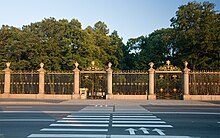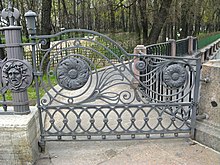Summer Garden (Saint Petersburg)
The Summer Garden ( Russian Летний сад ) is a park ensemble, a landscape gardening monument from the first third of the 18th century in the center of Saint Petersburg . It was laid out on the instructions of Tsar Peter I between 1704 and 1719.
history
The garden was laid out by Le Blond , Semzow and Matwejew. This is where the summer palace of Peter the Great , built between 1710 and 1714, is located .
Part of Usadiza Island was cut off for the summer garden. The baroque summer garden with its pruned trees was decorated with sculptures that Peter the Great had brought from Italy. In 1718, an English steam engine pumped water for the fountains from the Fontanka , which was later named for this reason , and later the fountains were fed from the 21 km long Ligovsky Canal, which supposedly brought medicinal water into the city. Peter used the garden to educate his contemporaries. Around 200 sculptures with accompanying explanations conveyed Western European culture and its ancient foundations. For the first time, sculptures were on public display in their nudity. The Russian nobility had to get used to European customs at the festivals, balls and receptions held here, such as socializing with wives or dancing with couples. Fireworks, mineral-covered grottos, an orangery, aviaries and menageries unfolded a cosmos of knowledge about nature and human skills. The nearby Kunstkammer was also part of the Enlightenment concept of Peter the Great.
The citizens of the city were only allowed to enter the park at the invitation of the ruler. The Russian Tsarina Elizabeth allowed the population to enter during the absence of the ruler. Every properly dressed person had the right to take a walk on the avenues. On May 25, 1752, the summer garden was opened to the public on Sundays and public holidays. On May 10, 1755, Elisabeth decided to open the park to the public on Thursdays as well. From May 24th, 1756, access to the common people was again only permitted in the absence of the Tsarina.
From 1771 to 1784 the famous grid was installed on the Neva side, which today is one of the symbols of Saint Petersburg. The draftsmen were the architects Georg Friedrich Veldten , Iwan Fok and Pjotr Jegorow . The grating on the Moika side was erected in 1826 by Ludwig Iwanowitsch Charlemagne .
As a result of the floods in 1777, the fountains and the "Grotto" pavilion were severely damaged. The fountains were not restored, in 1826 the old grotto was converted into a "coffee house" by the architect Carlo Rossi .
On April 4, 1866, Dmitri Karakosov made the first unsuccessful attempt to assassinate Tsar Alexander II when he finished a visit to the summer garden.
Today the garden, which originally extended to Nevsky Prospect, has been reduced in size and redesigned in the style of an English landscape garden.
Web links
Individual evidence
- ↑ Summer garden
- ↑ Wladimir Velminski: Das Theatrum Naturae et Artis, in: Karl Schlögel et al. (Hrsg.): Sankt Petersburg, Schauplätze einer Stadtgeschichte. New York / Frankfurt 2007, pp. 63–66
Coordinates: 59 ° 56 ′ 41 ″ N , 30 ° 20 ′ 8 ″ E


